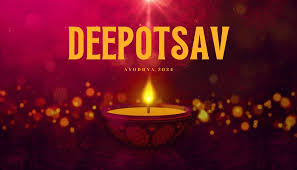Deepotsav in Ayodhya: A Festival of Lights and Culture
Deepotsav, celebrated in the ancient city of Ayodhya, is a magnificent festival that symbolizes the triumph of light over darkness and good over evil. This celebration coincides with the festival of Diwali, commemorating the return of Lord Rama, Sita, and Lakshmana to Ayodhya after their 14-year exile and the victory over the demon king Ravana. In recent years, Deepotsav has gained immense popularity, attracting thousands of devotees and tourists from across the country and around the world.

The Significance of Deepotsav
Deepotsav is deeply rooted in the cultural and spiritual fabric of India. It represents hope, joy, and new beginnings. For the people of Ayodhya, the festival holds a special place, as it honors their heritage and the legacy of Lord Rama. The lighting of thousands of diyas signifies the dispelling of ignorance and the arrival of prosperity and happiness.
Preparations Leading Up to the Festival
As the festival approaches, the city of Ayodhya transforms into a vibrant spectacle. Local artisans begin preparing intricate decorations, and shops are adorned with colorful lights and festive ornaments. The administration undertakes extensive arrangements to accommodate the influx of visitors. Streets are cleaned, and public spaces are beautifully decorated, creating a welcoming atmosphere.
In the days leading up to Deepotsav, locals engage in various rituals and activities. Homes are cleaned and decorated with rangoli (colorful patterns made from powdered colors) and lights, creating an inviting ambiance. The scent of traditional sweets fills the air as families prepare festive dishes, adding to the excitement.
The Grand Celebration
The highlight of Deepotsav occurs on the night of the festival when the city is illuminated with thousands of diyas. The banks of the Sarayu River are lined with these small oil lamps, creating a breathtaking sight. The illumination not only enhances the beauty of the river but also serves as a reminder of the joyous return of Lord Rama.
A major aspect of the celebration is the grand procession, which features cultural performances, traditional dances, and music that reflects the rich heritage of Ayodhya. Artists and performers showcase their talents, enthralling audiences with mesmerizing acts. The atmosphere is filled with joy and devotion, as people come together to celebrate their faith and culture.
The evening culminates in a spectacular fireworks display that lights up the sky, adding to the festive spirit. This moment of unity and celebration is not just about the grandeur; it embodies the collective devotion of the people, reinforcing the values of love, compassion, and community.
Spiritual and Cultural Impact
Deepotsav is more than just a festival; it is a profound cultural experience that brings together people of all backgrounds. It fosters a sense of unity and harmony, reminding everyone of the importance of communal ties. For many, participating in Deepotsav is an opportunity to reconnect with their roots, immerse themselves in spiritual practices, and celebrate the rich traditions of India.
The festival has also gained recognition beyond Ayodhya, with initiatives to promote tourism and cultural heritage. Efforts to document and showcase the various aspects of Deepotsav have led to a greater understanding of its significance, attracting visitors who wish to experience the unique blend of spirituality and festivity.
Deepotsav in Ayodhya is a celebration that encapsulates the essence of Diwali while highlighting the city’s rich cultural heritage. It is a time for reflection, gratitude, and joy as people come together to honor their beliefs and traditions. Whether through the flickering light of diyas, the enchanting performances, or the sense of community, Deepotsav serves as a beautiful reminder of the enduring power of light in our lives. As the diyas illuminate the city, they also illuminate the hearts of those who participate, making Deepotsav a cherished festival for generations to come.









